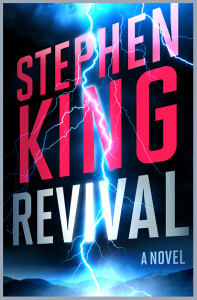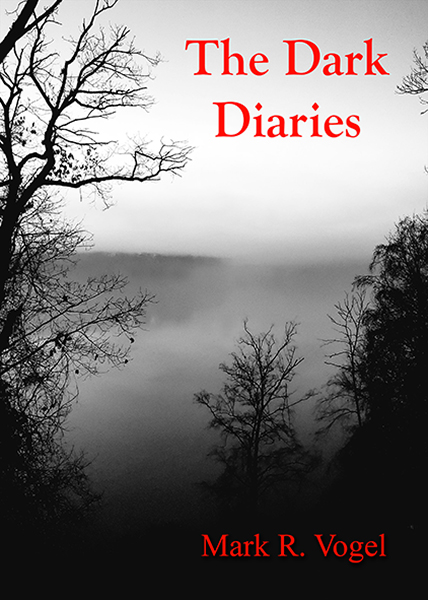
Stephen King
Gallery/Simon & Schuster
Reviewed by Michael R. Collings
When I began reading Stephen King’s Revival, I finished the first quarter in one sitting. Then for reasons that have nothing to do with the quality of King’s tale—which was excellent—I interrupted Revival long enough to read and review Larry Correia’s Monster Hunter International. Almost as soon as I posted that review, I settled back into the world of Jamie Morton, the Reverend Charles Daniel Jacobs, obsessions and addictions of the worst and deadliest sorts, and the debilitating effects of aging.
I am glad for the interruption.
Not that it altered anything in Revival, but rather that it allowed me an intriguing perspective on the way(s) horror can work.
Both novels, it turns out, incorporate a key character who has lost the most important thing in his life and is willing to do anything—to risk anything—to assuage his grief. In MHI, Raymond Shackleford IV opens a rift between this world and another, seeking to retrieve his dead wife; and in doing so he establishes a breach for the Old Ones that wait patiently beyond the skin of this universe, poised to penetrate it and reclaim the Earth. In Revival, Jacobs has lost his wife, his child, and his faith, and immerses himself in a fanatical search for a means to restore them; and eventually Jamie Morton must confront a terrifying and impossible choice in his desire to save the life of his first love—and the two men’s quests merge in the image of a doorway between worlds, beyond which awaits horror, terror, disillusionment…and the Old One, poised to enter and reclaim the Earth.
Put that bluntly, the books sound tediously similar. In fact, however, they provide a fine example of how variable and malleable the Lovecraft Mythos can be.
The first quarter of Revival is firmly set in this world, albeit in the 1960s, and everything—details of landscape, of family life, of attitudes and responses, of “brand-name” references—draws the reader inescapably back to a past but authentic (or authentic-seeming) reality. Nothing about it suggests supernatural horror. The language is Stephen King at his storytelling best: direct and clear, colloquial and contemporary, with none of the linguistic furbelows or outré vocabulary the term Lovecraftian implies. It could be a mainstream novel about a young boy, Jamie Morton, and his first trial of faith.
In the remainder of the book, however, things shift subtly and, at first, imperceptibly as the story continues to 2014 and everything in Morton’s life shifts, echoing the escalating and inevitable changes of over half a century. About two-thirds of the way in, as part of a discussion between Morton and Jacobs about the essentials of electricity, Jacobs refers to the fifteenth-century author of a sinister and forbidden book: De Vermis Mysteriis, ‘The Mysteries of the Worm”…and the novel is suddenly more than an exposé of a fictional faith-healer and begins its purposeful descent into madness, chaos, the unknowable, and the unthinkable. By way of Robert Bloch, it has entered Lovecraft territory and, just as everything has altered in Morton’s life, primarily as a result of his drug addiction, so everything in the structure and texture of Revival alters. Characters are defined by their fears and their madness; actions become increasingly surreal; and settings emphasize more and more the need for and dangers of isolation…finally bringing the novel full circle as Morton returns to the location of a keystone childhood memory.
Along the way, King demonstrates the linguistic potential of the title, Revival, which began as a reference to a new production of an old play. While there are no plays per se in the novel, in one sense or another the initial drama between Jacobs and Morton and their oddly imperative sense of connection is revived as they encounter each other in unexpected places and replay their anomalous relationship, each time gaining additional understanding of what it implies, although—for Morton at least—never quite fully.
Revival also, of course, has the sense of a theological or religious awakening, often associated with tent-preachers. When readers reach the point in the novel where an aging Jacobs has returned to the ministry as an itinerant healer, using his electrical discoveries to change believers’ lives, it almost seems as if the title has reached fulfillment.
Yet there is more. Lovecraft’s universe meets Poe’s in a final, truly horrifying episode of revival—of returning the dead to life. By that time, the momentum of conflict between Morton and Jacobs has reached such a pitch that, in spite of Morton’s exertions to the contrary, the old play of emotion and connection begins one final time…with devastating consequences.
Overarching all, however, is the theme of obsession and addiction. Every major character must battle something that impels toward destruction: physical, emotional, and spiritually. Much time is spent on Morton’s descent into drug abuse and his unexpected release. Others’ backgrounds form part of the web of addiction that ultimately spreads to infect everyone. And if there is any single moral to be derived from Revival, it deals less with religion and the spiritual than with the single dictum: Addiction, to matter the kind, is deadly.
- Killing Time – Book Review - February 6, 2018
- The Cthulhu Casebooks: Sherlock Holmes and the Miskatonic Monstrosities – Book Review - January 19, 2018
- The Best Horror of the Year, Volume Nine – Book Review - December 19, 2017
- Widow’s Point – Book Review - December 14, 2017
- Sharkantula – Book Review - November 8, 2017
- Cthulhu Deep Down Under – Book Review - October 31, 2017
- When the Night Owl Screams – Book Review - October 30, 2017
- Leviathan: Ghost Rig – Book Review - September 29, 2017
- Cthulhu Blues – Book Review - September 20, 2017
- Snaked: Deep Sea Rising – Book Review - September 4, 2017


